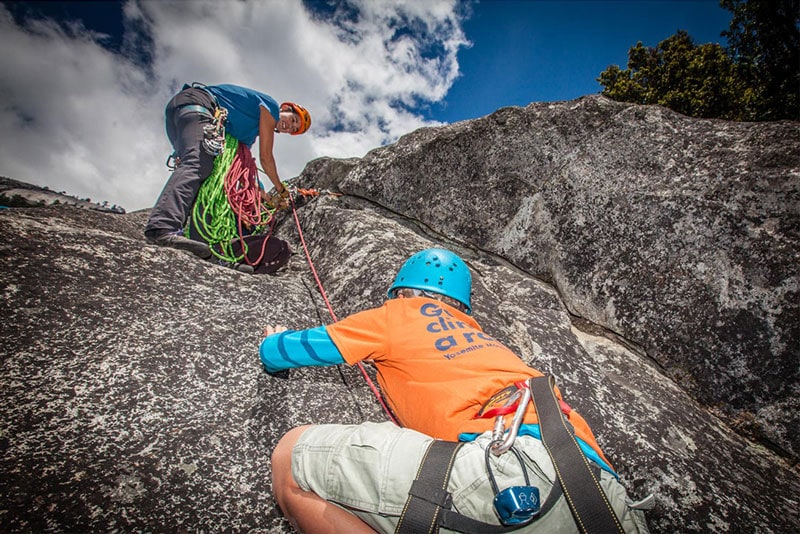Climbing El Capitan stole the national spotlight with Alex Honnold’s death-defying free-solo climb on “El Cap”. The process of preparing and executing that dream was made into the Oscar-winning National Geographic documentary, Free Solo, by Jimmy Chin and Elizabeth Chai Vasarhelyi.
Maybe you’ve seen it.
It is the portrait of a straight-speaking, dedicated rock climber with incredible mental control who managed to do what was previously thought impossible. He climbed El Capitan without safety ropes, putting himself intentionally into a “you slip, you die” situation that goes on for one tenuous pitch after another for 3000 feet (900 m).
But that isn’t the only way to climb El Capitan.
In some ways what Alex did is the most mind-blowingly difficult thing to do, but there are other styles of climbing El Cap that are much harder in other ways.
And although this compelling story rightfully captured the minds and hearts of people all over the country it sits in context of one inspiring story after another that plays out on the steep walls of El Capitan.
So many ways to Climb El Capitan
Climbing El Cap is hard (really hard) no matter how you do it. However, “hard” can take on a lot of different forms and there is a lot of nuance in the way that different people approach the goal of getting to the top.
Climbing Routes
First of all, there are different routes on El Capitan. Roughly a third of Yosemite Bigwalls: The Complete Guide is devoted to the climbing equivalent of trail maps for El Capitan, each route with its own name. These range from relatively straight-forward beginner big walls like The Salathe Wall to desperate expert-only scare-fests like The Tempest, and from famous climbs like The Nose that often have multiple climbing parties on it at once to routes that haven’t even seen a second ascent.
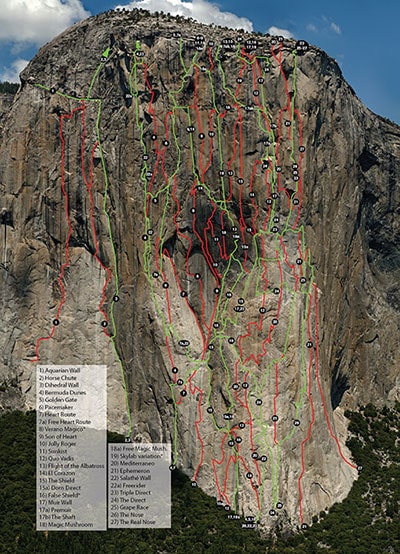
Aid, Free, Solo and Free Solo – what’s the difference?
There are different styles of climbing and the climber lingo to describe them often confuses people.
Free soloing
Free soloing – the style that Honnold recently made famous, means an ascent that is done alone without any ropes for protection/safety. However, people are often confused because climbers also talk about free climbing and soloing. These are very different styles that both involve ropes, and are much more common in general and particularly on big walls like El Capitan.
Free climbing
Free climbing is climbing with ropes but without using those ropes for upward progress. The ropes catch the climber if they fall, but all the climbing is done by pulling or pushing on the rock itself. Depending on the features of the rock available for the climber to grab, this can be relatively easy, or nearly impossible.
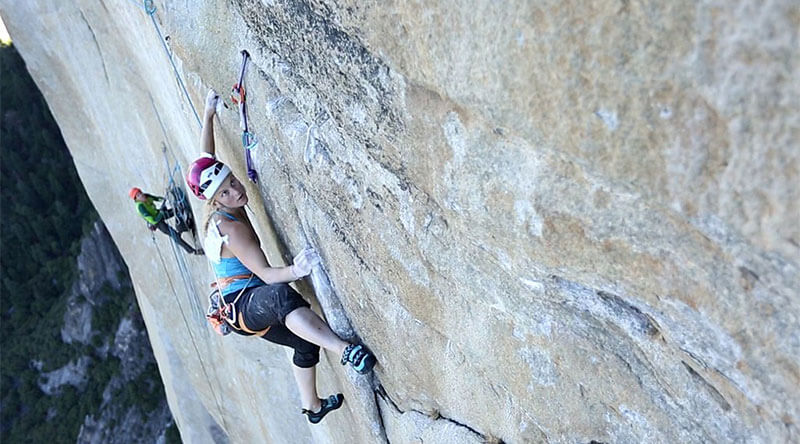
With a safety rope, climbers can try harder things when they are free climbing instead of free soloing. When projecting a route, climbers take dozens of falls as they work out the sequence of moves that will work for them. In the US, climbers measure the pure gymnastic difficulty of a route using the Yosemite Decimal System (YDS). Initially, the easiest climbs were rated 5.0 and the hardest climbs were supposed to be 5.10. However, as climbers got better, it became obvious that the scale had to keep getting harder, so we ended up with 5.10a, 5.10b, 5.10c, 5.10d. Then climbers started climbing things harder than 5.10d, and we turned the dial to 11. Climbers put up 5.11a, b, c and d routes, before adding 5.12, and 5.13, etc. with the letter grades for each level. So far the hardest climb in the world is 5.15d. That route, Silence, is only 45 meters (just under 150 feet) long, but the most technically difficult route in the world.
When Alex Honnold chose an El Capitan route to free solo, he picked one of the easiest big wall free climbing routes on El Capitan, Free Rider (5.12d). Then he spent a lot of time over many years “freeing” the route (with ropes) before daring to attempt it free solo (without ropes).
Usually, free climbing attempts on El Capitan tend to follow old climbing routes. Lynn Hill made a huge splash in the climbing world when in 1993 she became the first person, male or female, to “free The Nose”. Since then only a few people have been able to repeat her effort.
More recently, the film Dawn Wall showcases Tommy Caldwell and Kevin Jorgeson’s 2015 ascent of a visionary free route on El Cap of the same name. Dawn Wall is rated 5.14d overall, with 18 pitches (climbing sections) out of 32 pitches total, that are technically harder than anything on Free Rider. Then, on top of the drama of cutting-edge free climbing, add in the special kinship that is built between climbing partners. If you enjoyed Free Solo, definitely check this one out too. Alex Honnold even makes a brief appearance in this film too.
Aid climbing
Aid climbing, or “aiding” came first and most common on El Capitan and other Yosemite big walls. Climbers place gear in the rock and then use that gear to make upward progress. In case you are tempted to think that this is easy, let me assure you that it’s not. Easier? Yes. Easy? No. Aid climbing has its own separate difficulty rating depending on how solid the climbing gear is and what kind of gear is used. An A0 climb has solid gear, close together, but on an A5 route climbers are linking together so many marginally secure pieces that an unexpected fall could pop out all of the pieces sending the climber and all partners to their deaths.
For most people, covering the amount of terrain on a face the size of El Cap involves at least a little bit of aid climbing. For example, The Nose is rated 5.14a for free climbers, but most people will climb it as a 5.8 free climb with relatively easy aid climbing through the harder free sections.
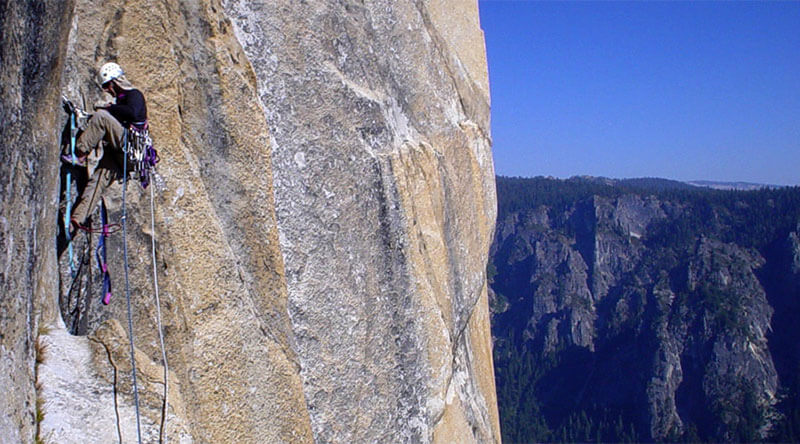
Solo climbing
Solo climbing means climbing alone, but may be free climbing or aid climbing, with ropes. So, if a climber says, “I soloed The Nose”, what she means is simply that she climbed the The Nose route on El Capitan without a partner. On a big wall like El Capitan, a solo ascent can be brutal because you’re covering the same ground 3 times. The first time, you ‘lead’ the pitch, a section of a climb, trailing multiple ropes behind you. Then you descend down to the anchor by lowering yourself down the rope (rappelling) and removing all of the safety gear that you left behind while leading. Then you have to climb the rope again up to the top where you can haul all your gear up to your new position and repeat the process.
Speed climbing
Now take all those different styles of climbing and try to do them fast. That’s speed climbing.
Indoor speed climbing, like what you will see in the Olympics, is entirely free climbing and climbers don’t have to worry at all about placing safety gear. The route follows a standard course that is replicated all over the world. Speed climbers rehearse the exact moves needed to climb the route in a burst of anaerobic strength, and it looks like flying. El Cap speed climbing is almost nothing like that.
Speed ascents of El Capitan focus more on precision, efficiency and risk management. Sure, people are trying to move quickly, but the military saying “Slow is smooth, smooth is fast” rules the day. Depending on the style of ascent, the climbs can take anywhere from a few hours to more than a day.
Stopping to place gear takes time, so whenever possible climbers will free any sections they can climb quickly with minimal safety gear. When the going gets hard, they switch to aid climbing to keep moving.
Still, speed records depend a lot on the style of climb.
Here are a just a few examples to give you a sense of how long it takes speed climbers to climb The Nose on El Capitan (times for other routes vary substantially). For reference, the first ascent party, Warren Harding, Wayne Merry and George Whitmore spent 47 days pioneering the route. A typical modern party on The Nose will take 3-4 days to finish the climb using a mix of aid and free climbing.
- John Long, Jim Bridwell and Billy Westbay completed the first Nose In A Day ascent in 1975 (using aid).
- After being the first person to free The Nose in 1993, Lynn Hill returned in 1994 to complete the climb free in a day, completing the climb in 23 hours.
- At that time, the fastest times for free + aid ascent was by Hans Florine and Peter Croft at 4 hours 22 minutes. Now, that record is under 2 hours. (Alex Honnold and Tommy Caldwell summited in 1:58:07 on June 6, 2018).
- The current women’s record is 4:43 (Chantel Astorga and Mayan Smith-Gorbat in 2013).
- On August 5, 2016, a current Yosemite Mountaineering School climbing guide, Miranda Oakley, became the first female ever to solo The Nose in a day, taking 21:15 to climb it by herself.
El Capitan Camping
Climbers would call it “bivying” as in “We bivyed on El Capitan.”
Regardless of what you call it, if it takes 3-4 days to climb El Capitan, you need to have some way of spending the night.
How does that work?
Sleeping and Spending the Night
If possible, climbers will stop on a ledge system and spread out their sleeping bags there. However, sometimes there aren’t any convenient ledges, or the ledges are too small or sloping.
In that case, a prepared climber will carry a portaledge with her. These “portable ledges” are like heavy-duty aluminum frame cots that hang from an anchor instead of standing on legs. From this comfortable stance, climbers can relax, cook dinner and bed down in relative comfort with one of the most amazing views imaginable.
But make no mistake, this isn’t ultralight backpacking.
Portaledges are heavy. They weigh nearly 20 pounds all by themselves.
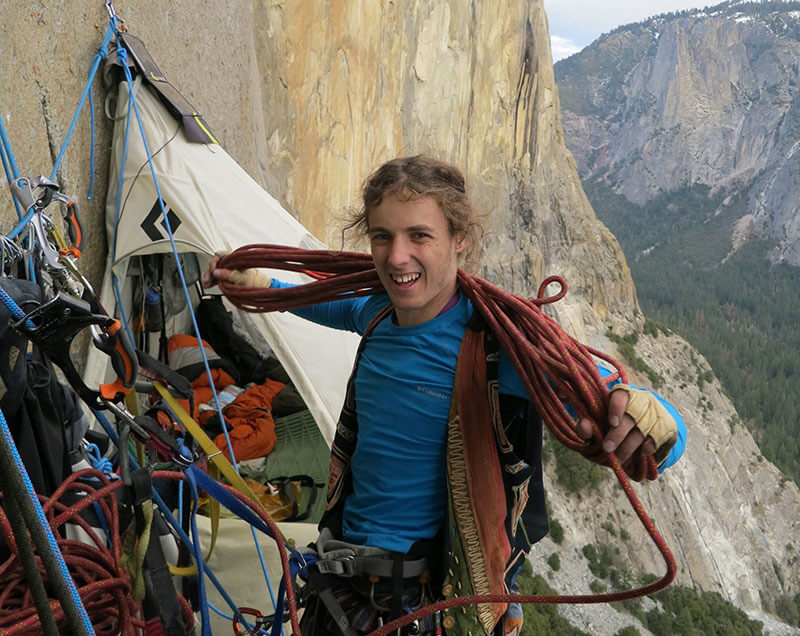
Finding Water on El Cap
Plus, unlike a backpacker who can often refill his water from a nearby river, El Capitan climbers bring all the water they need with them from the ground up. If you count on a gallon of water per person per day, that weighs more than 48 pounds of water for two people spending only 3 days on the route. That means the water and portaledge alone are 68 pounds before you add in any food, cooking gear, sleeping bags/pads, extra clothes or any of your actual climbing gear.
Because water weighs so much, it’s precious and almost everything that is carried up will be either drunk or eaten. Conserving every drop of water makes you appreciate faucets, and especially hot and cold running water in a whole new way!
Unlike backpacking meals, there is no point in dehydrating food when you also have to carry the water needed rehydrate it anyway. On big walls, foods like canned fruit in juice that you can drink afterward go back on the menu.
For really long ascents, some climbers cache water along the route prior to the climb itself, going up and down repeatedly to make sure they have enough supplies along the way. For a 19-day effort like Tommy and Kevin’s ascent of Dawn Wall, friends helped by ferrying supplies including food and water up to them along the way.
Hauling
In addition to the weight, if the route isn’t overhanging so that the haul bag hangs away from the wall, climbers also have to contend with the friction of the haul bag scraping against the granite and getting caught on features in the rock.
Lighter climbers and those on longer routes often end up resorting to pulley systems that provide a mechanical advantage in order to haul these unwieldy loads.
Bathroom matters
Also, people always want to know – what about, you know, when you have to go? You can’t bury it in solid granite, and you’re on a small ledge or portaledge so it’s not like you can disappear into the bushes. With multiple parties on the same route at one time, the only reasonable thing you can do is forgo modesty and pack it out.
You can buy commercial kits like the wag bag, or just ask your partner to look the other way while you do your business in a plastic ziploc. Double bag. Maybe add some kitty litter or wrap the final package in aluminum foil to help control the smell. Then store the package securely in a container that won’t break even if it’s being dragged up the side of a granite cliff. It’s not exactly glamorous, but much better than having the party above you let fly.
Learning to climb El Capitan
Learning to climb a big wall like El Capitan takes a lot of practice. Most of the time people start in the climbing gym or on short walls to make sure their systems are efficient. Getting small things right – like the length of aiders, the slings the second person used to climb the rope, or practicing how to “lower out” if the line of gear is horizontal instead of going straight up – can make a huge difference in the amount of energy it takes to complete a long climb.
Once these basic systems are dialed in, the next step is a smaller Yosemite Wall like Leaning Tower or Washington Column, before embarking on climbs the size of El Cap.
To get a head start on learning all the skills needed for big walls, go climbing with a guide from Yosemite Mountaineering School. As the only authorized guide service in Yosemite, these guides have climbed El Capitan dozens of times and are great teachers for climbers of any experience level.
